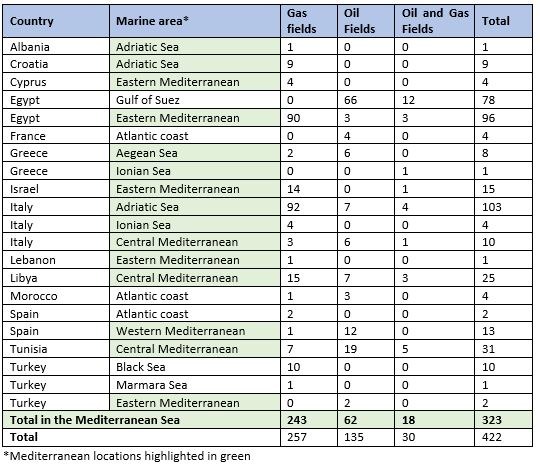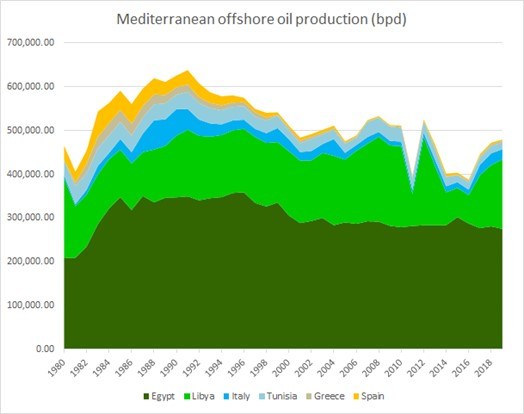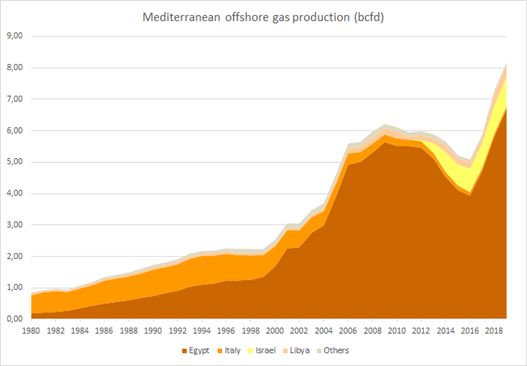Decommissioning
According to the recent Study on trends and outlook of marine pollution from ships and activities and of maritime traffic and offshore activities in the Mediterranean prepared by REMPEC in collaboration with UNEP/MAP secretariat, MEDPOL, SPA/RAC and Plan Bleu, a total of 323 oil and gas fields are found in the Mediterranean Sea. Oil and gas production currently takes place in four major areas: (i) the Southern Levantine Sea where Egyptian and Israeli offshore production occurs (mainly gas), (ii) the Channel of Sicily (Italian and Tunisian activities), (iii) the Gulf of Gabes (Tunisia) and the neighbouring Libyan marine area, and (iv) the northern Adriatic, where most of the Italian offshore gas activities are concentrated and where Croatian gas production is located.
Table: Number of oil and gas offshore fields for each Mediterranean country 
Note that some of the countries’ own fields which are located outside the Mediterranean; related numbers are provided for completeness of the information. The total number of Mediterranean fields considers those located within the basin.
Data source: Clarksons Research Offshore Intelligent Network, data retrieved on 08.06.2020. Figures retrieved from EP/MED WG.498/Inf.4.
Oil production is characterized by a decreasing trend in the Mediterranean (including marked variability after 2001, as compared to the substantially stable global trend since 2001). On the other hand, Mediterranean Sea plays a more significant role in gas production at the global level, with the trend in offshore gas production showing a clear and marked increase since the 1980s. Egypt is the main offshore gas producer in the Mediterranean, historically followed by Italy. In recent years, the Italian production of offshore natural gas decreased significantly, while the production of Israel has greatly increased, in particular owing to the discovery of, and production in the rich Leviathan gas field. In the coming years, other Eastern Mediterranean countries are expected to enter the offshore gas market as producer.

 Figure: Top: Trend of offshore oil production in the Mediterranean Sea (bpd = barrels per day), Data retrieved on 29.06.2020;
Figure: Top: Trend of offshore oil production in the Mediterranean Sea (bpd = barrels per day), Data retrieved on 29.06.2020;
Bottom: Trend of offshore gas production in the Mediterranean Sea (bcfd = billion cubic feet per day), Data source: Clarksons Research Offshore Intelligent Network (Data retrieved on 04.06.2020).
Compared to other regions, the Mediterranean Sea is a small producer of offshore oil and gas. While offshore gas explorations have expanded in recent years, there have been no major discoveries of offshore oil fields after 2010. As an important number of old offshore platforms are approaching the end of operational lifetime, their decommissioning is a challenge to be addressed in the near future. Offshore oil production is projected to slightly decrease in the Mediterranean, while offshore gas extraction is expected to significantly increase, due to the expansion of the sector in the Levantine basin, involving also deep and ultradeep waters (link to regional study).
Decommissioning of offshore platforms is currently a highly relevant topic, not just for the Mediterranean but also in other regions. It is proposed as a priority topic for the next biennium 2022-2023. The technical evaluation of the removal methods, as well as their sustainability implications, environmentally sound management and optimal treatment should be discussed. The Barcelona Convention Offshore Oil and Gas Group (OFOG) Sub-Group on Environmental Impact presents an excellent regional platform for this discussion.

